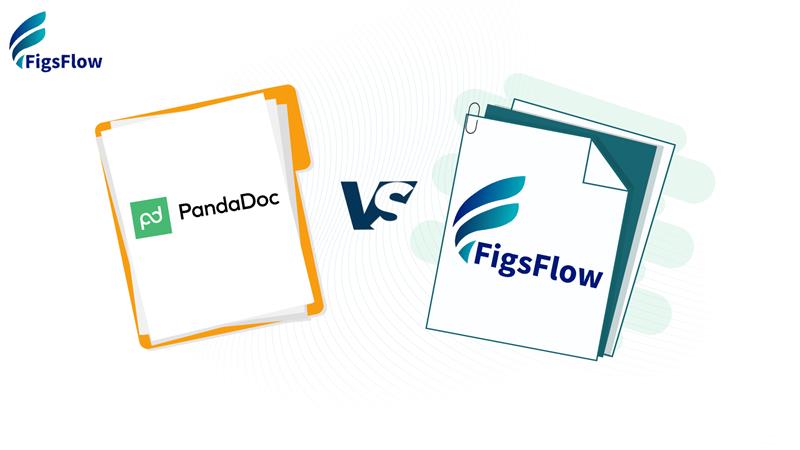In this post, we’re getting PandaDoc and FigsFlow head-to-head.
If you’re trying to choose the right proposal and engagement software for your firm, you’ve come to the right place.
In today’s post, we’re going to compare two popular accountancy software- FigsFlow and PandaDoc in terms of:
- Ease and flexibility of proposal creation
- Accuracy and adaptability of the service pricing calculator
- Ease of LOE creation
- Service pricing functionality
- CRM functionalities
- Pricing and value
- Unique features
- And lots more.
You can use our detailed comparison and the final decision-making dashboard at the end to make an informed choice between PandaDoc and FigsFlow.
Introducing: The Two Solutions
In the red corner, we have PandaDoc – a complete agreement management solution that helps businesses create, automate, sign, and analyse documents. It is based in San Francisco, California.
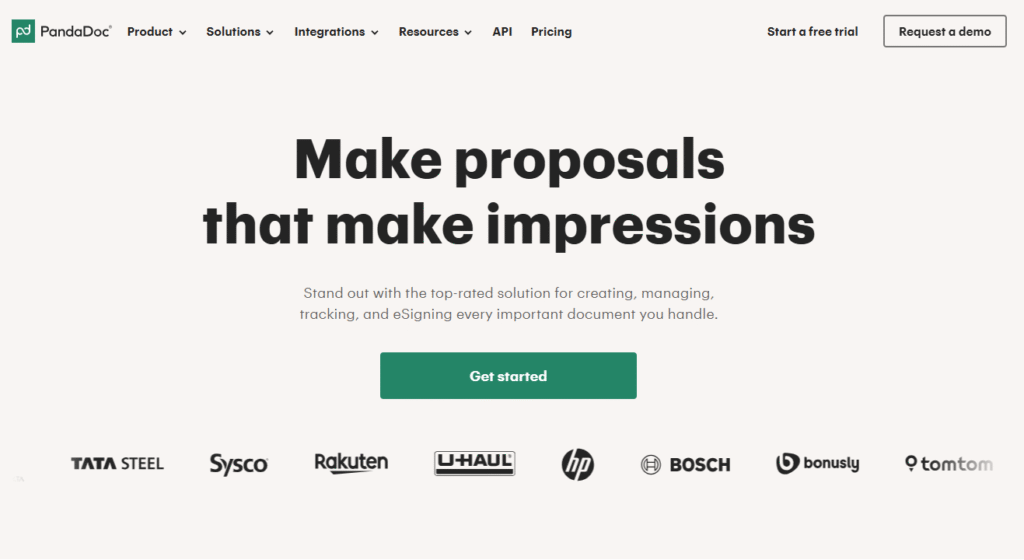
And in the blue corner, we have FigsFlow —a proposal, pricing, and engagement software for accountancy, tax advisory, and bookkeeping firms.
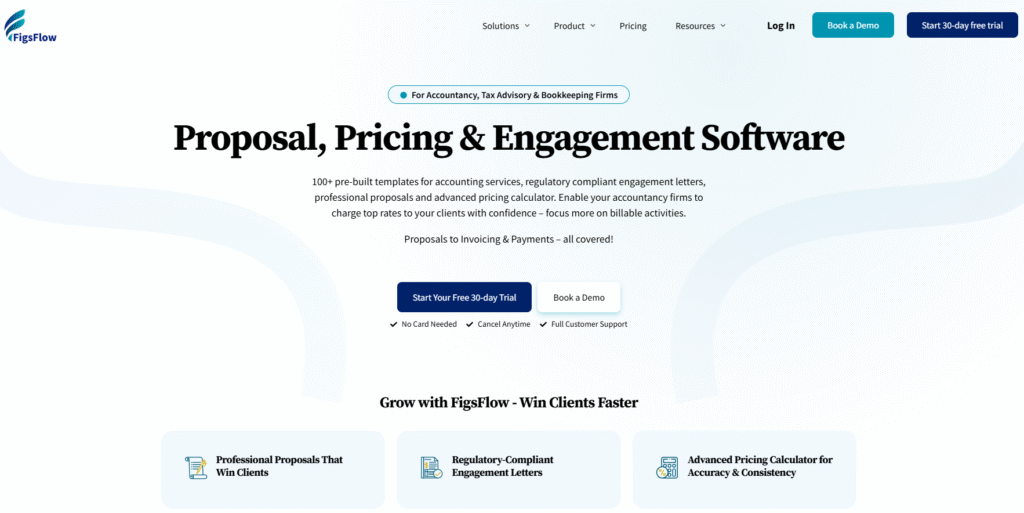
Let’s take a brief overview of each platform before diving into a detailed comparison.
| Features | PandaDoc | FigsFlow |
|---|---|---|
| Mostly Used for | Creating, sending, and signing business documents like proposals, contracts, and quotes | Creating a proposal and LOE, pricing services and onboarding clients |
| Core Ideology | Make agreements faster, cleaner and transparent | Make compliance easy for accountants |
| Starting Price | $35/month if billed monthly $19/month if billed annually |
£10/month if billed monthly £8/month if billed annually |
| AML & Identity Verification Integration | Available in Business and Enterprise plans, $2 per ID check attempt | Coming soon for all plans starting £8/month |
| Time to Create Proposal & Engagement Letter | 30 minutes | Less than 30 seconds |
| Customer Reviews | 4.5/5 | 5/5 |
| Client Communication Tools | Features include Google Mail, Outlook, in-app comments, real-time notifications and SMS delivery | Features Google Mail, Outlook, In-app messaging, Live chat and E-messaging |
| Best for | Sales, Marketing, Legal and General Business teams | Accountancy, Tax Advisory and Bookkeeping firms |
| Engagement Letter Compliance | Not designed to meet accounting compliance requirements | Aligned with UK regulatory standards and major professional bodies like ACCA, ICAEW, ATT, AAT and more |
So, which tool is the overall best value?
Let’s find out.
Which Tool Puts Accountants First?
First, let’s examine which software is specifically designed for accountants.
PandaDoc
PandaDoc aims to help businesses earn trust with every interaction by making their agreements faster, cleaner and more transparent.
We started PandaDoc with a clear goal: to make work easier. What began as a way to help two founders break free from inefficient processes has become a global platform trusted by tens of thousands of companies. We believe business documents should be fast, flexible, and free of frustration—so every team can focus less on paperwork and more on what moves them forward.
–PandaDoc
FigsFlow
FigsFlow is built around the simple principle: Compliance and convenience should not be the trade-off for accountancy, tax advisory and bookkeeping firms.
At FigsFlow, our mission is to simplify how accountancy firms start and grow client relationships – with professional proposals, regulatory-compliant engagement letters, an advanced pricing calculator, and seamless client onboarding, all in one place. It’s everything we wish we had when working every day.
–Raju Gajurel, CEO & Founder of FigsFlow
Bottom Line:
FigsFlow wins the battle by miles. Despite both software programs aiming to improve client interaction, PandaDoc lacks focus and serves a broad audience. However, FigsFlow is laser-focused on accountants.
Which Tool Is Better for Proposal Creation?
Next up: proposal creation.
Let’s see, which tool makes it easier to craft polished, professional proposals and gives you more room to customise them your way?
PandaDoc
In PandaDoc, you can create a proposal by clicking on the “+ Create document” icon on the home dashboard.
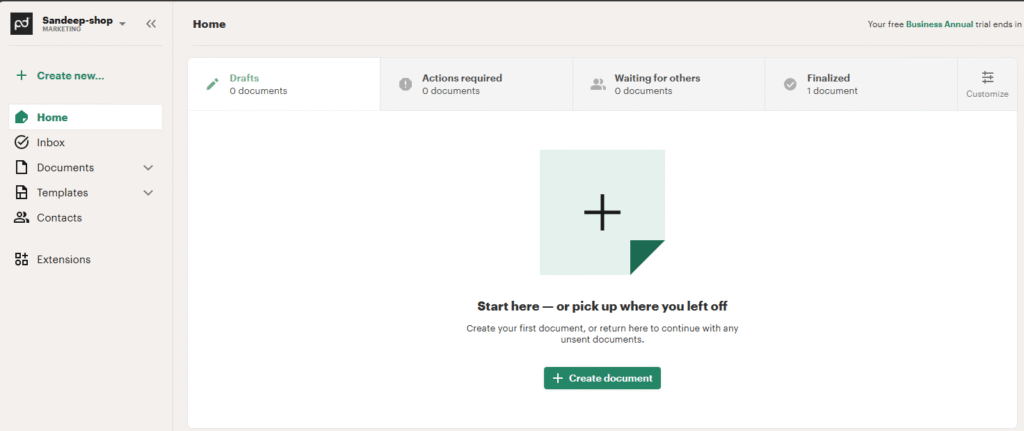
Then, you’re required to go through 3-step process and fill in the details.
- Get Started
You can choose from the range of proposal templates covering everything from marketing, business, sales, to video and one-page proposals.
- Add Recipients
You can rename the document, add a business email and single or multiple recipients.
- Review Content
In this section, you can customise your proposal using a simple drag-and-drop approach.
And you’ve done. You can send the proposal via a link to your clients. The whole process takes less than 10 minutes, and it’s surprisingly smooth.
But there’s a catch.
Templates for accountancy and bookkeeping services are rarely available. As a result, you often end up tweaking marketing or sales templates to fit your specific needs. This can easily turn into a 1-hour job.
FigsFlow
In FigsFlow, generating the proposal is as simple as clicking on the “Generate Proposal” icon on the dashboard.
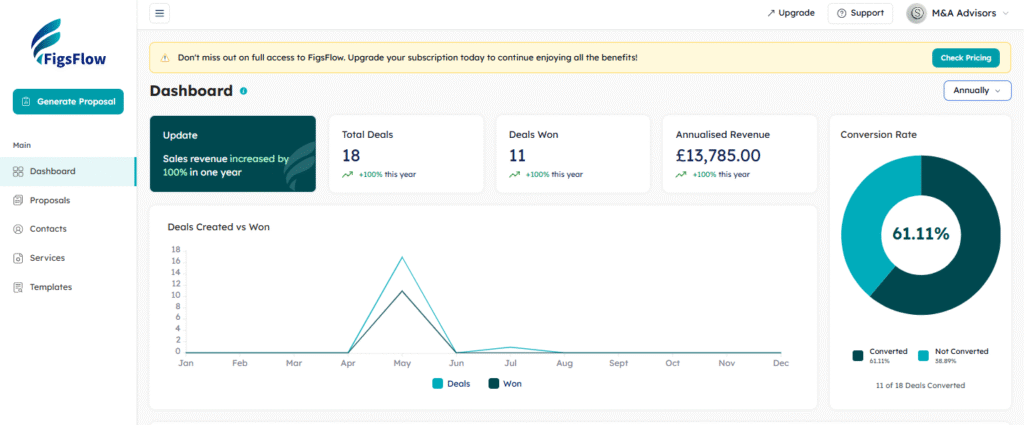
Then, you’re required to follow two steps paths- add and preview.
- Add
You can add or create your own services or service packages and enter the client’s details, like point of contact and entity name. The software auto-calculates service prices and VAT for you.
- Preview
You can use the live preview window to make changes on the spot and see exactly what the client will see in the proposal. Once everything looks good, you can send the proposal via email without leaving the platform or save it as a draft for later.
FigsFlow comes with pre-built proposal templates for 100+ accounting services and even automates proposals for any new services you create. So, you never have to start your proposal from scratch.
And the best part is that its workflow is intuitive and enjoyable. As a challenge, we once built a winning proposal for year-end tax advisory planning in under 40 seconds and with just 10 clicks.
Let’s see some of the proposal customisation features available in PandaDoc and FigsFlow.
| Customisation Features | PandaDoc | FigsFlow |
|---|---|---|
| Customise the Proposal to Reflect Brand Identity | Full design control with Canva integration; customise text, videos, tables, TOC and more | Basic branding options—set colours, fonts, cover image, Limited compared to PandaDoc |
| Automate Proposal Creation | Not available, need to create a proposal from scratch or tweak existing ones | Create professional proposals for 100+ accountancy services in under 30 seconds |
| Set Expiry Dates and Reminders for the Proposal | Only available in the Business or Enterprise plan | Set custom expiry dates and reminder emails for any proposal |
| Track Proposal Status in Real Time | Tracks proposal status (draft, sent, viewed, signed, declined, expired) with manual updates available | Track proposal as Lost, Won and Draft |
| Embed Multimedia in Proposals | Supports embedding images, videos, GIFs, and audio to make proposals more engaging | Embed brochure and images as PNG/JPG |
| Upsell with Add-ons on the Proposal | Not supported, need to create line items manually | Add associated services with a single click |
Bottom Line:
FigsFlow wins PandaDoc by miles in the accounting world, thanks to the built-in templates for accountants, tax advisors, and bookkeepers.
However, if you work in sales, marketing, or SEO, PandaDoc is the perfect choice.
Which Tool Offers Smart Service Pricing Features?
Next up: service pricing calculator.
Or which tool offers the most useful pricing calculator for accountancy services?
For this, we put both tools to the test and tried pricing dozens of services inside each platform.
Here’s what we found…
PandaDoc
PandaDoc doesn’t offer service-specific templates- it’s just the general ones. Therefore, the pricing displayed is often vague and not tailored to accounting or tax services.
Even when templates include pricing, they’re more like placeholders that let you know where the numbers go, not the actual calculated values.
That means you will need to enter your prices from scratch manually.
On the plus side, you can apply discounts and VAT (either as a percentage or fixed amount) and adjust quantity and unit prices as needed.
FigsFlow
FigsFlow offers an advanced pricing calculator for accounting, tax advisory and bookkeeping services. It factors in industry benchmarks, firm profitability, fixed costs and dozens of other variables to calculate pricing that makes sense.
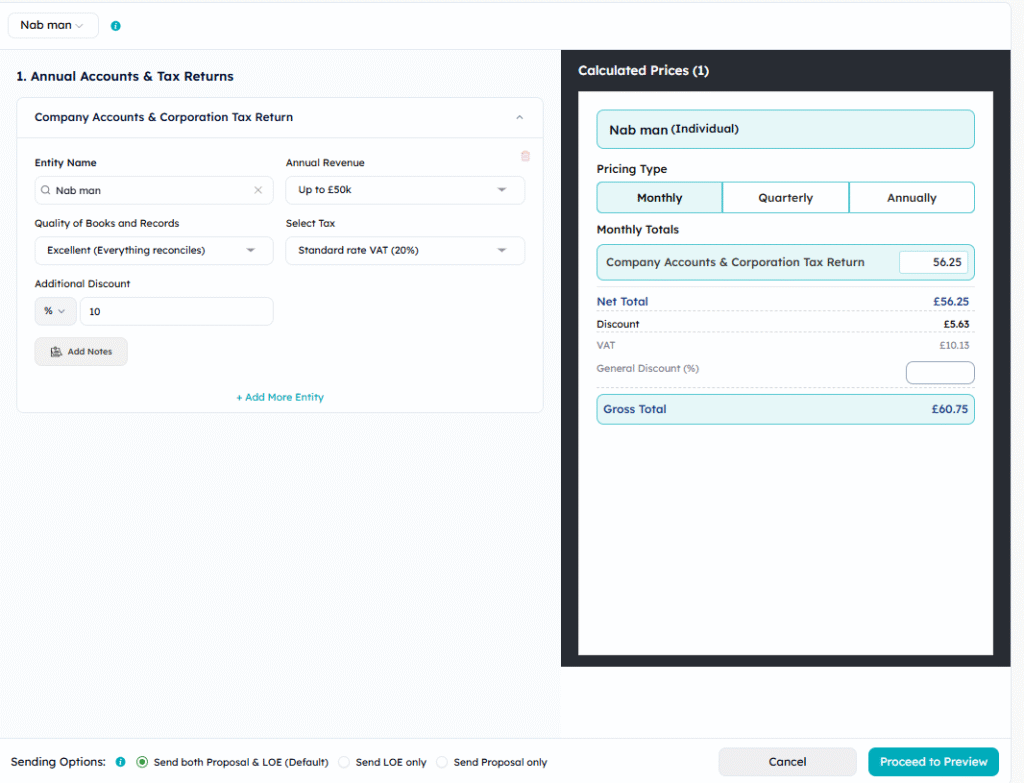
We compared FigsFlow’s suggested pricing with rates charged by firms across the UK, and they were a close match.
Additionally, the pricing library is easy to access and can be used to customise calculations based on the firm’s costs and targets. And the best part is that you can override any price manually.
To price services in FigsFlow, just:
- Add services from the library
- That’s it. FigsFlow automatically calculates pricing and applies relevant VAT and discount rates as needed.
FigsFlow pricing not just looks good on templates but also works for accountants.
Now that you know how the pricing calculator works in each tool, let’s dive into the key service pricing features they offer.
| Service Pricing Features | PandaDoc | FigsFlow |
|---|---|---|
| Flexible Pricing Methodology | No automated pricing, manually write terms, payment cycle, and schedules | Supports cost-plus pricing, billing in cycles, or one-off payments |
| Real-time Price Updates | Update price or quantity, auto recalculates VAT and discounts in real time | Any changes are updated in real-time |
| Multi-currency Support | Supports multi-currency via lookup tables, but only one currency per pricing table | Not supported, works with “£” only |
| Parameter-based Pricing (Firm's revenue, profits, etc) |
Supports parameter-based pricing only in enterprise plan | Can price service based on company annual revenue, and customise the parameters via service library, available across all plans |
| Manual Price Override | Lacks automated pricing adjustment, only manual input available | Can override price, discounts, and VAT |
Bottom Line:
FigsFlow wins the service pricing game by miles. Where PandaDoc offers little more than a price placeholder, FigsFlow provides up-to-date pricing for 100+ accounting services and a customisable library to tailor prices as per firm’s needs.
Which Tool Handles Engagement Letter More Effectively?
Both PandaDoc and FigsFlow let you create a Letter of Engagement (LOE).
But which one does it better?
Let’s find out…
PandaDoc
Like most proposal tools, PandaDoc allows you to create proposals and engagement letters simultaneously.
But here’s the catch.
In PandaDoc, both the proposal and the engagement letter are merged into a single document. So, you can’t send just one or the other. It’s all or nothing.
And that’s not even the worst part.
It falls short where it matters the most- compliance. It doesn’t include key elements such as AML obligations, professional indemnity, disengagement terms, or GDPR-specific data holding requirements mandated by professional bodies like ACCA and ICAEW.
Speaking from my personal experience, using PandaDoc for an engagement letter felt like using Canva for layout and ChatGPT for clauses.
And that’s on a perfect day.
FigsFlow
In FigsFlow, the engagement letter is created alongside the proposal, just like PandaDoc.
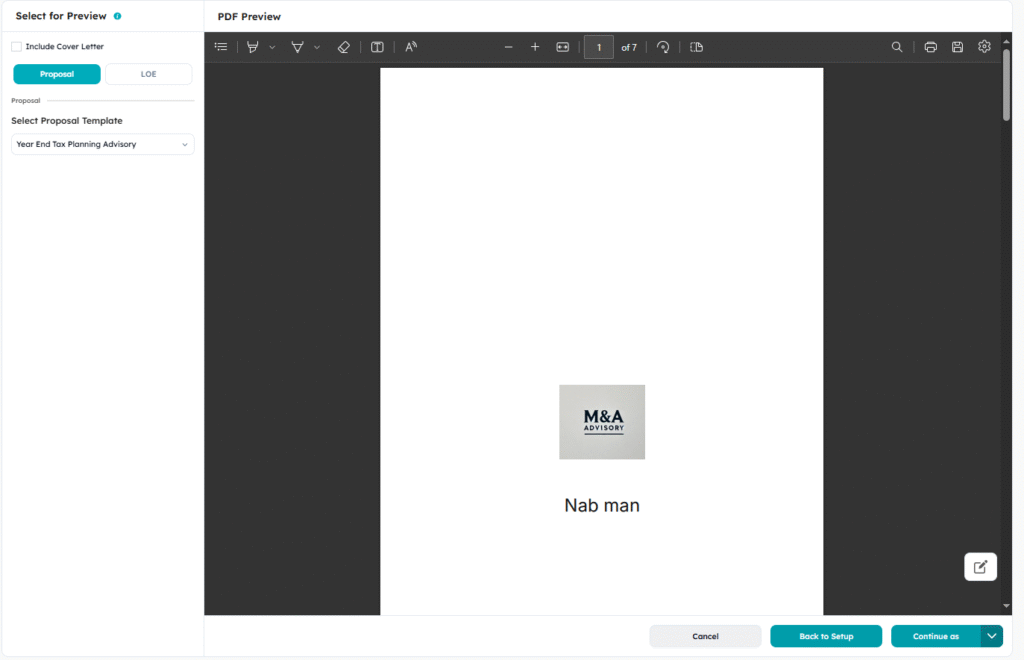
You can choose to send both the proposal and the LOE or just the LOE by simply clicking on the simple checkbox at the bottom of the “Generate Proposal” section.

Now the best part:
FigsFlow offers regulatory-compliant LOE templates that are packed with clauses written by accountants and legal experts and are regularly updated to reflect changes in law and industry expectations.
You can customise any of the existing templates or duplicate and tweak them to build your own custom templates library.

This is where FigsFlow truly delivers on its promise:
Compliance and convenience shouldn’t be a trade-off, and here, they aren’t.
Now, let’s look at some of the additional LOE features available in each software.
| LOE Related Features | PandaDoc | FigsFlow |
|---|---|---|
| Built-in Regulatory Compliant LOE Templates | No UK-specific regulatory-compliant templates, only general customizable ones for accounting and tax services | Built-in templates for UK and global bodies, including ACCA, CIOT, CIMA, ICAEW, ATT, and more |
| Time to Create LOE | 30 minutes | Less than 30 seconds |
| Multiple E-signatories Support | Available | Supports multiple e-signatories for client and team signatures |
| Auto-updates for LOE Templates | Templates must be manually updated to track regulatory changes | Accountants and legal experts regularly update templates to reflect current laws and market trends |
| Create a Custom LOE Template Library | Create from scratch or tweaking marketing/sales templates takes an hour | Edit or duplicate existing LOE templates, or create from scratch |
| Built-in AML & Identity Verification Checks | Available in Business and Enterprise plans, includes government ID and biometric checks | Coming soon on all plans, ID verification fully integrated within the platform |
Bottom Line:
FigsFlow is the obvious winner in the LOE battle.
Where PandaDoc handles engagement letters like a generalist with just one document, no compliance and zero accounting-specific support, FigsFlow offers exclusive features to automate engagement letters and ensure compliance every step of the way.
Which Tool Has the Stronger CRM Capabilities?
Most tools stop with just document management.
But accountants need more. They need contact visibility, reminders, tracking and workflows that don’t fall apart after signature.
Let’s see which tool actually supports your client relationships.
| Feature | PandaDoc | FigsFlow |
|---|---|---|
| Contact Management | Connect with CRM or Zapier to auto-fetch contacts, add manually, or import from Google | Integrate with Zapier, enter manually, or upload Excel file; filter by individual or organisation clients |
| Task Management | No built-in tasks; integrates with external apps to automate tasks on approval | Tasks auto-trigger on proposal won; assign tasks to team members |
| Deal/Proposal Tracking | Tracks draft, sent, viewed, completed, declined and expired | Tracks won, lost, and draft status |
| Email Integration | Integrates with Gmail and Outlook; offers reusable email templates (Saved Messages) accessible to all team members | Integrates with Gmail and Outlook; offers dozens of email templates and lets you build your own by duplicating existing ones |
| Reporting & Analytics | Available only in the Enterprise plan; includes document funnel, conversion rates, and revenue tracking | Available across all plans; shows visual analytics on revenue, conversions, deals, and service-level revenue breakdown |
| Automated Reminders | Available only in Business and Enterprise plans; auto-email or SMS reminders to signers | Available across all plans; sends automated reminders for proposal and engagement letter |
| Data Storage | GDPR, HIPAA, and SOC 2 Type II compliant, encrypted storage | GDPR compliant, data stored within European Economic Area (EEA), encrypted and secure |
Bottom Line:
FigsFlow wins by miles. Where PandaDoc relies on integrations, FigsFlow offers built-in tools for tasks, tracking, reminders and reporting. All these features are custom built for accountants from start to finish.
Which Tool Integrates Better with Accounting Software?
Next up: Integrations
Both PandaDoc and FigsFlow claim to integrate with popular accounting, CRM and practice management tools.
But which platform brings more relevant integrations for accountants?
Let’s find out.
PandaDoc
Think of any mainstream HR, payment, CRM or productivity software. There’s a good chance PandaDoc integrates with it.
In fact, its website proudly lists almost 40 integrations covering everything from admin tools and storage systems to design platforms and payment gateways.
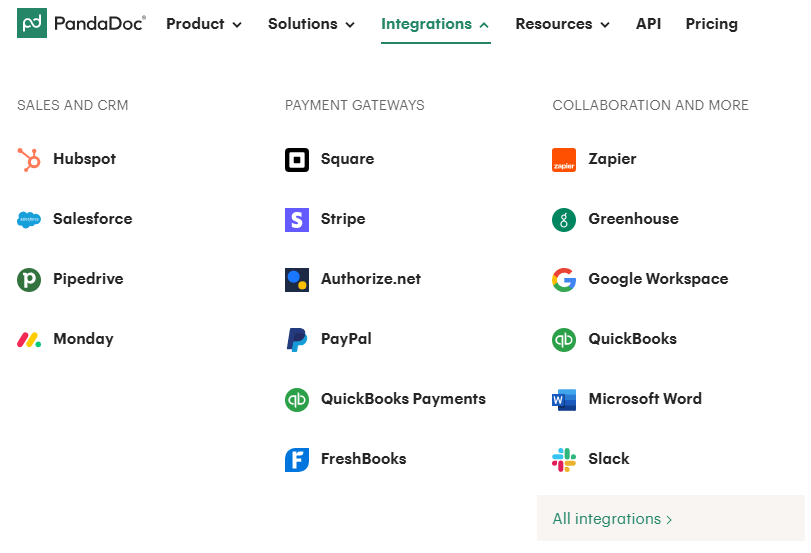
But how many of these integrations are useful for accountants?
It integrates with HubSpot and Salesforce for CRM, Stripe and PayPal for payments, QuickBooks for accounting records and Canva for incorporating eye-catching images and illustrations in the documents. These are solid tools and useful for accountants.
However, it lacks integrations with popular accounting software like Xero or Zoho Books. It doesn’t integrate with Companies House either.
Thus, PandaDoc users won’t be able to auto-fetch data directly from the source into their documents. This adds extra manual work such as re-entering client records, uploading signed files and switching between platforms to complete onboarding or compliance checks into your workflow.
So, while it covers a wide range of general-purpose apps, it misses the key integrations that matter the most to accountants.
FigsFlow
FigsFlow integrates with several accounting, practice management, CRM and data integration software like Xero, QuickBooks, Stripe, Gmail, Outlook and more.
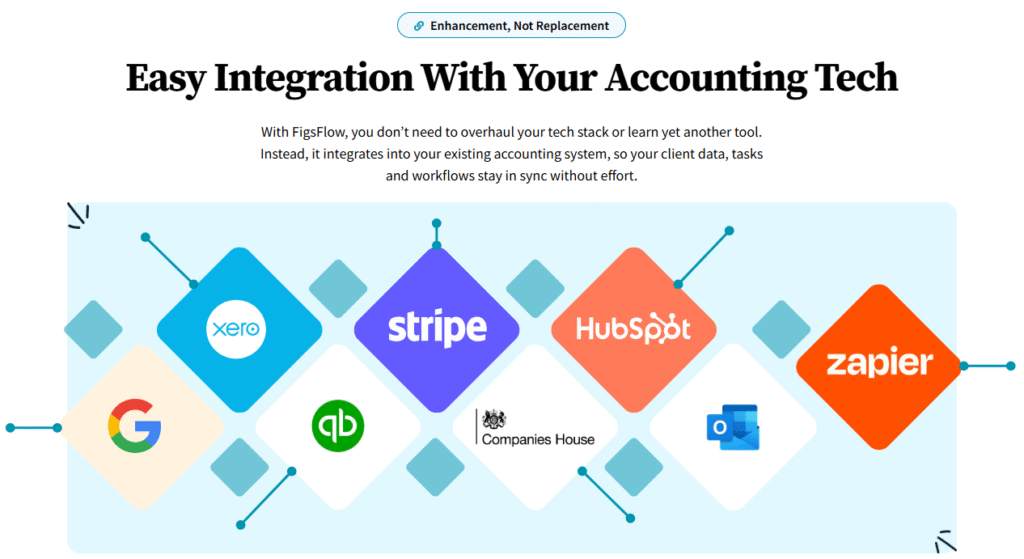
FigsFlow also integrates with Companies House, allowing you to auto-fetch company data and stay updated with changes in company status.
At first glance, it might seem like FigsFlow integrates with fewer apps than PandaDoc. However, here’s the catch: every integration FigsFlow offers is purpose-built to eliminate repetitive tasks from the accountant’s plate.
And most importantly, FigsFlow connects with Zapier, which is compatible with over 6,000 other apps. This allows you to automate data transfer between tools without needing custom setups.
Bottom Line:
FigsFlow is the clear winner in terms of integrations. This is mostly because it offers integrations relevant to accountant workflows and simplifies their day-to-day tasks.
Unique Features: What Sets Each Tool Apart?
Now that we’ve covered the core features, let’s look at what sets each tool apart.
In other words, let’s see: What unique features do PandaDoc and FigsFlow offer?
PandaDoc
PandaDoc has some cool features.
You can create proposals, get them signed and even collect payments without switching platforms.
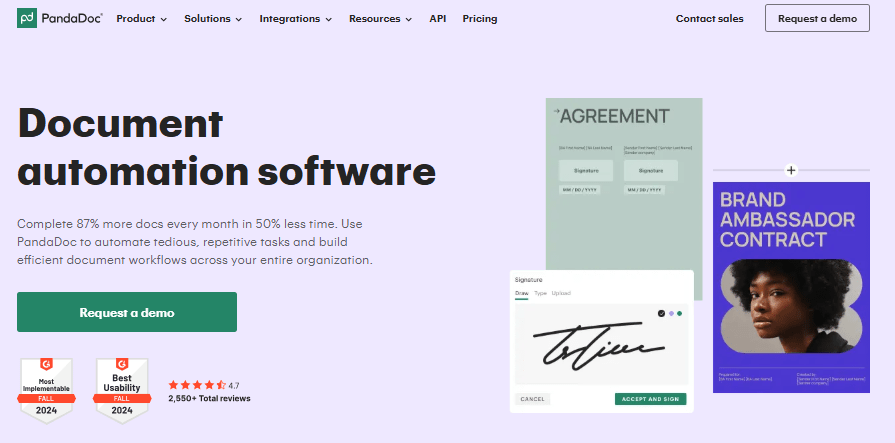
It also comes with advanced CPQ tools. That means you can build complex pricing tables, add products or services from a catalogue, and automate totals.

Additionally, PandaDoc offers advanced e-signature tool that supports ID verification, audit trails, and compliant signatures.

And finally, you can sync with popular CRMs and apps via Zapier.
FigsFlow
FigsFlow has numerous unique features that most proposal and engagement software, including PandaDoc, lacks.
The most obvious one is its suite of 100+ pre-built templates tailored specifically for accounting services.
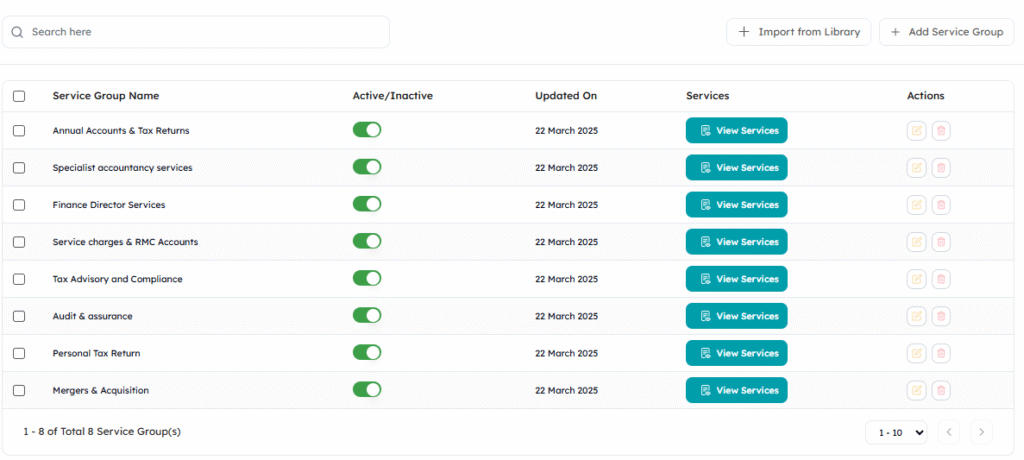
It also provides regulatory-compliant Letter of Engagement (LOE) templates for professional bodies worldwide. So, you don’t need to draft or research an engagement letter; just pick, personalise, and send.
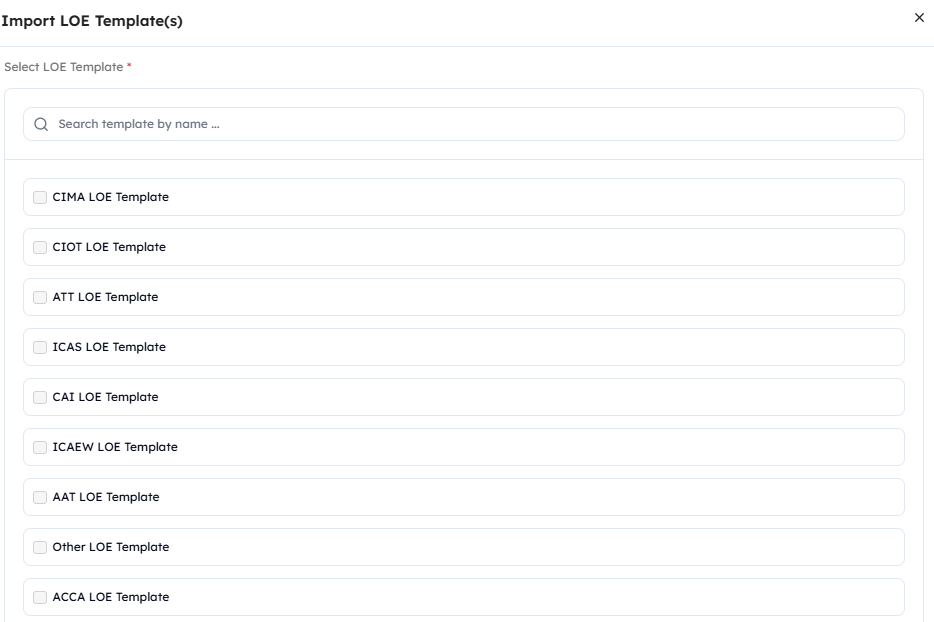
It takes less than 30 seconds to create and send winning proposals and an engagement letter. Alternatively, you can skip the proposal entirely and send just the engagement letter —a feature that’s rare in most proposals and engagement letters.

FigsFlow also offers an advanced service pricing calculator designed especially for accounting services. The default rates are close to market pricing, and you can tweak the prices based on client size, revenue or custom parameters.
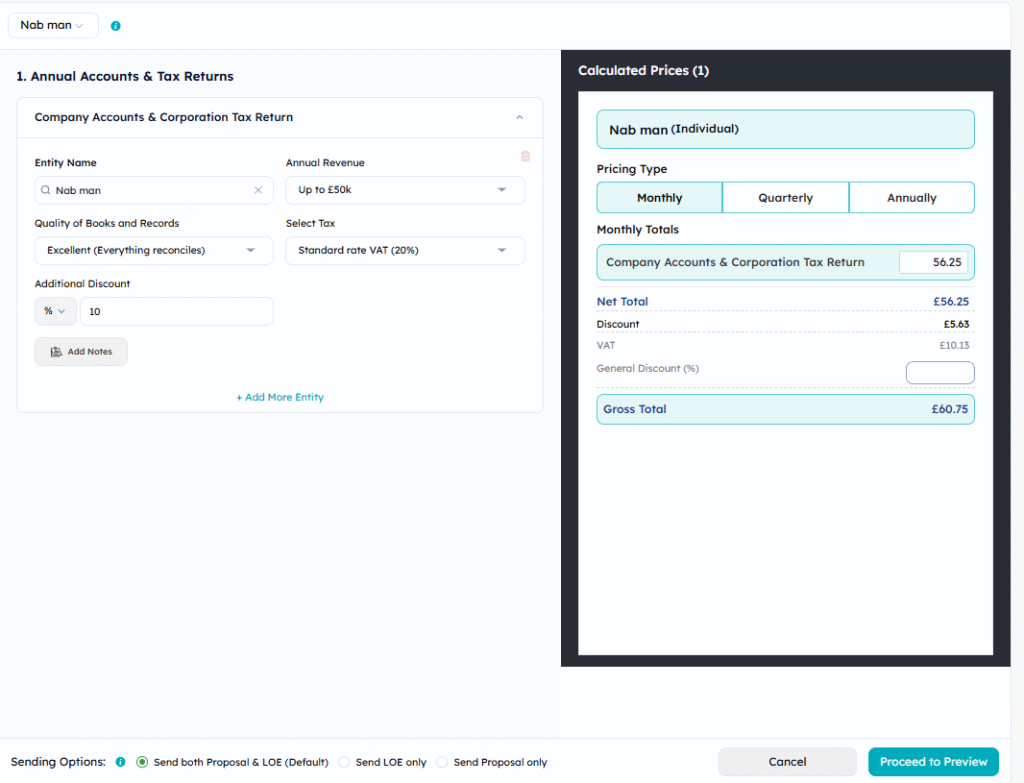
It also comes with a visual dashboard that shows revenue, conversion rates, and deal status. This feature is available across all plans.
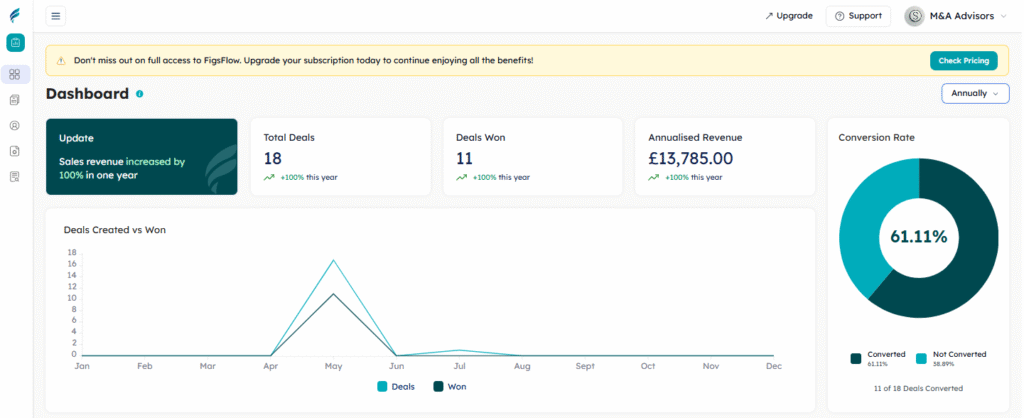
Additionally, it is rolling out integrated AML and ID verification soon. It makes compliance easier for accountants, and they don’t have to juggle multiple platforms.
Bottom Line:
FigsFlow wins the unique features battle by miles. While PandaDoc offers some solid features, it comes nowhere near FigsFlow. That’s mostly because FigsFlow offers accountants specific features like regulatory compliant LOE templates, tailored pricing and tools that actually work.
Which Tool Is the Best Overall Value?
Next up: Pricing
In other words, which tool provides the most value for your spend?
PandaDoc
PandaDoc offers a simple three-tier pricing model: Starter ($19), Business ($49) and Enterprise (custom pricing). Each tier adds more features, from basic document handling to advanced workflows and integrations.
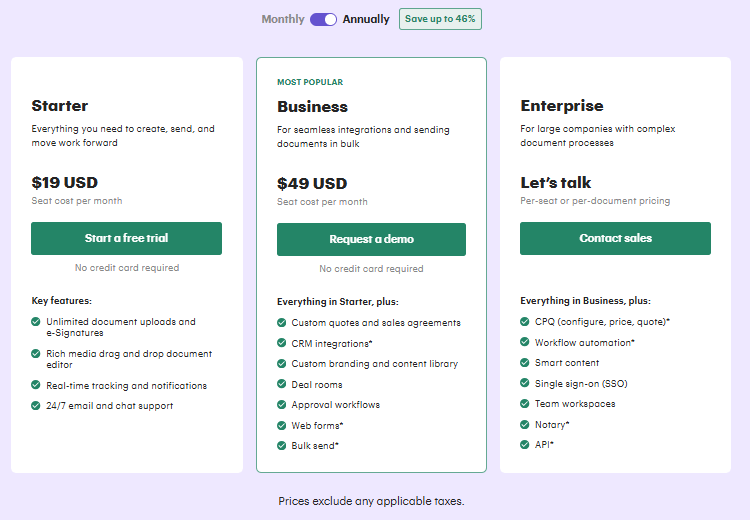
You’ll find most essential features of PandaDoc in the Business plan ($49/month). This includes CRM integrations, approval workflows and document analytics.
However, advanced options like CPQ (configure, price, quote), workflow automation, team workspaces and API access are only available in the Enterprise plan, which requires custom pricing.
FigsFlow
FigsFlow follows a four-tier pricing model: Starter (£8/month), Essential (£24/month), Standard (£60/month) and Professional (£120/month). Each plan is designed to match the size and the needs of accounting firms from solo practitioners to larger teams.
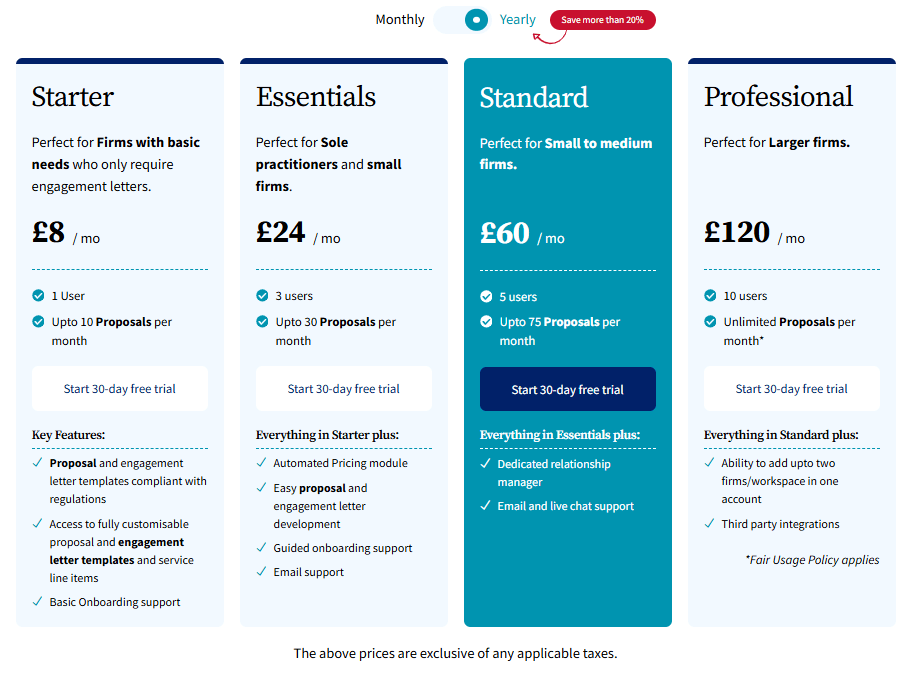
Most core features of FigsFlow are available in the Standard plan (£60/month), which includes 75 proposals per month and 5 user access. It also features a dedicated relationship manager and email and live chat support.
If you’re managing multiple firms or need unlimited proposals, the Professional plan (£120/month) is the one to go for.
Feature-to-Pricing test
The pricing alone doesn’t really help much. So, let’s map out the key features accountancy, tax advisory and bookkeeping firms need and see which tools offer them and at what cost.
| Must-Have Features for Accountants | PandaDoc | FigsFlow |
|---|---|---|
| Regulatory-Compliant Letter of Engagement (LOE) Templates | Not available | Available in all plans (£8/month to £120/month) |
| Customisable & Professional Proposal Templates | Only general-purpose template available starting from $19/month | Available across all plans; professional templates for 100+ accounting services |
| Advanced Service Pricing & Fee Calculator | Available only as an add-on in the Enterprise plan | Available across all plans |
| Multiple E-signatory Support | Available across all plans starting $19/month | Available across all plans starting £8/month |
| AML & Identity Verification Integration | Available in Business and Enterprise plans, $2 per ID check attempt | Coming soon for all plans starting £8/month |
| Detailed Sales & Engagement Analytics | Available in Business and Enterprise plans starting $49/month | Available across all plans starting £8/month |
Bottom Line:
FigsFlow is the clear winner for accountants. It offers all key features across affordable plans starting at £8/month, while PandaDoc locks most essentials behind expensive add-ons and higher tiers. For value and accountant-specific needs, FigsFlow beats PandaDoc hands down.
PandaDoc Vs FigsFlow: Decision-Making Checklist
Here’s a summary of how each tool performed across the key categories we’ve covered.
We’ve rated them on a scale of 1 to 5, based on how well they meet the needs of modern accountancy firms.
| Category | PandaDoc | FigsFlow | Notes |
|---|---|---|---|
| Accountant-Centric Workflows | 2 | 5 | PandaDoc is generalist; FigsFlow is built only for accountants. |
| Proposal Creation | 3 | 5 | PandaDoc is flexible but FigsFlow is faster and made for accountants. |
| Service Pricing Calculator | 2 | 4 | PandaDoc is manual and generic but FigsFlow is smart, tailored and automated. |
| Engagement Letter Creation | 2 | 5 | PandaDoc lacks compliance; FigsFlow is built for UK accountants. |
| CRM Capabilities | 3 | 4 | PandaDoc relies on integrations; FigsFlow has built-in CRM for accountants. |
| Relevant Integrations | 3 | 5 | PandaDoc is broad. FigsFlow integrates what accountants actually use. |
| Unique Features | 3 | 5 | PandaDoc is versatile. FigsFlow packs accountant-specific and time-saving tools only. |
| Overall Value for Accountants | 3 | 5 | PandaDoc gets pricey for key features. FigsFlow offers more at relatively cheaper prices. |
| Total Score | 21/40 | 38/40 |
And the Winner Is
Both PandaDoc and FigsFlow are excellent proposal software and in some cases, they complement well with each other.
However, PandaDoc is ultimately built for a general audience. That means accountants are forced to tweak, patch and improvise their way through proposals and engagement letters that weren’t designed for their industry.
FigsFlow, on the other hand, is purpose-built for accountancy, tax advisory and bookkeeping firms. Everything within FigsFlow, from proposals, engagement letters, to service pricing and compliance, is tailored to make an accountant’s life easier.
So, FigsFlow is the clear winner.
FAQ
PandaDoc is a versatile tool for many industries. However, it lacks accountant-specific features and compliance templates, which means accountants often must spend extra time customising templates.
FigsFlow is the must-have software for accountants. It speeds up client onboarding, ensures compliance and automates proposal and engagement letters.
FigsFlow. It is designed specifically for accountants and offers compliance-focused templates, automated workflows and pricing tools that work in the real accounting world.
FigsFlow. It offers accountant-focused features, such as automated pricing, compliant LOE templates, and a service pricing calculator, starting at just £8 per month. For reference, PandaDoc starts at $19/month and GoProposal at £65/month.
